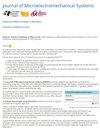Single-Crystal Silicon Thermal-Piezoresistive Resonators as High-Stability Frequency References
IF 3.1
3区 工程技术
Q2 ENGINEERING, ELECTRICAL & ELECTRONIC
引用次数: 0
Abstract
This paper reports on single-crystal silicon (Si) thermal-piezoresistive resonators (TPRs) achieving ~0.2ppb-level frequency stability in phase-locked loop (PLL) measurements. A pair of resonators operating in a balanced-bridge configuration is presented, with one device being driven at resonance and the other used to null the parasitic background responses. The resonance frequency of the driven TPR has been measured over 40 hours with closed-loop continuous tracking by PLL and yields an Allan deviation作为高稳定频率参考的单晶硅热压阻谐振器
本文报道了单晶硅(Si)热压阻谐振器(tpr)在锁相环(PLL)测量中实现0.2ppb级频率稳定性。提出了一对工作在平衡桥结构中的谐振器,其中一个器件在谐振时被驱动,另一个用于消除寄生背景响应。驱动TPR的谐振频率已经用锁相环闭环连续跟踪测量了40小时,在$\tau \approx 4.95$ s的平均时间内产生了Allan偏差$\sigma _{\text {A}} \approx 2.66$ ppb,这是迄今为止研究的所有Si TPR中报道的最佳值。此外,与锁相环一起实现了外部直流电源反馈回路,以提高TPR的频率稳定性,在$\tau \approx 1.2$ s处达到$\sigma _{\text {A}} \approx 0.236$ ppb,这是所有报道的Si MEMS同类产品中最佳的短期频率稳定性。这一结果表明,这种具有精确直流控制的tpr可以潜在地实现与振荡器电路中使用的现有最先进谐振器相当或更好的频率稳定性,同时显着降低外部热控制要求和功率需求。[2024-0121]
本文章由计算机程序翻译,如有差异,请以英文原文为准。
求助全文
约1分钟内获得全文
求助全文
来源期刊

Journal of Microelectromechanical Systems
工程技术-工程:电子与电气
CiteScore
6.20
自引率
7.40%
发文量
115
审稿时长
7.5 months
期刊介绍:
The topics of interest include, but are not limited to: devices ranging in size from microns to millimeters, IC-compatible fabrication techniques, other fabrication techniques, measurement of micro phenomena, theoretical results, new materials and designs, micro actuators, micro robots, micro batteries, bearings, wear, reliability, electrical interconnections, micro telemanipulation, and standards appropriate to MEMS. Application examples and application oriented devices in fluidics, optics, bio-medical engineering, etc., are also of central interest.
 求助内容:
求助内容: 应助结果提醒方式:
应助结果提醒方式:


